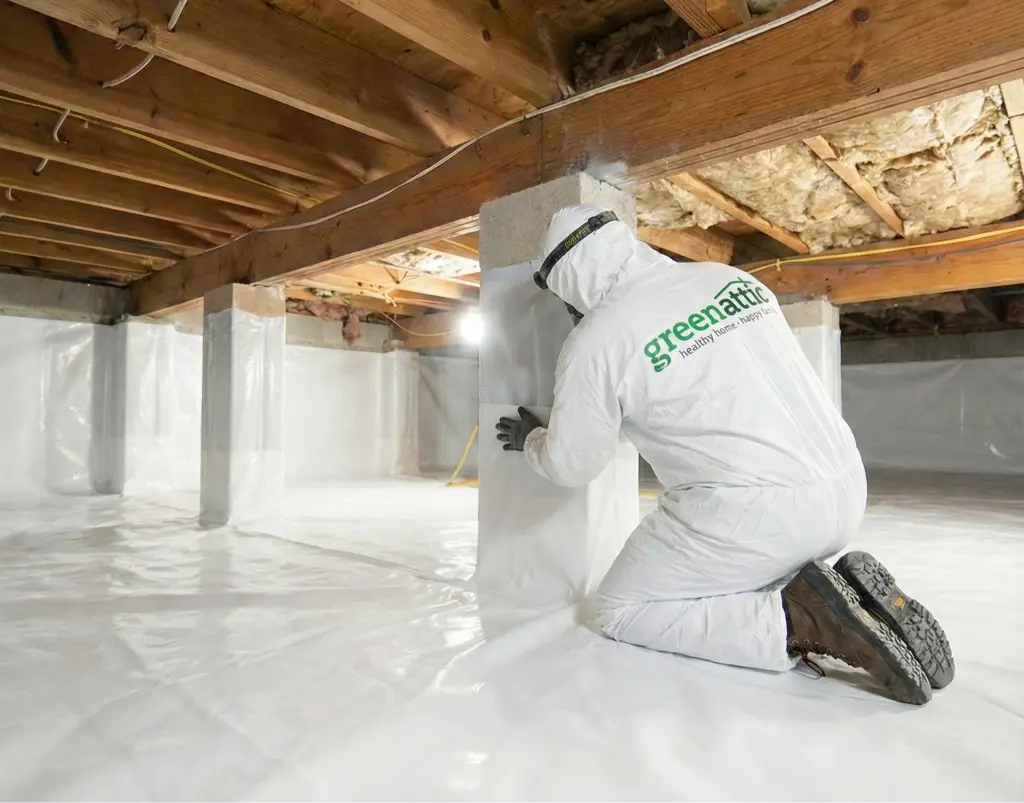A crawl space is the space beneath a home's floor, typically with unfinished walls and a dirt floor, requiring crawling for access. While not as versatile as a basement, it serves a crucial role, providing access for tradesmen like plumbers, electricians, and HVAC experts to maintain the house's mechanics.
Spray foam crawl space encapsulation provides homeowners with various benefits, including enhanced air quality. By encapsulating the crawl space, it prevents the entry of outside air and moisture, contributing to improved indoor air quality.
Crawl Space Height

An ideal crawl space height is around 3 feet, facilitating easier repairs. If it's below 18 inches, accessibility becomes a significant constraint for repairs beneath the home.
Repairing in an undersized crawl space may even necessitate pulling up flooring. This applies to professionals like plumbers, electricians, and home inspectors, with industry standards stating that spaces with less than 24 inches vertical clearance or access openings smaller than 16 inches by 24 inches may not be entered.
Detecting Crawl Space Issues

Homeowners often avoid exploring their crawl spaces due to their cramped, dark, and dirty nature, often inhabited by spiders, mice, or insects. Recognizing an issue becomes challenging without regular checks. There are three common ways to identify crawl space problems:
- Sagging or sloping floors: Noticeable changes in the floor's level or an unusual bounce indicate potential issues.
- Musty odor: A strong, musty smell emitting from the crawl space can lead to headaches, nausea, or typical allergic reactions like sneezing and watery eyes.
- Reports from tradespeople: Plumbers, electricians, or HVAC contractors may discover problems during their work and inform you of issues such as mold, insect activity, or standing water in the crawl space.
Can You Encapsulate Your Crawl Space With Spray Foam? Closed cell spray foam resists moisture, preventing mold and mildew in crawl spaces. Encapsulation with spray foam acts as a barrier against water, safeguarding your crawl space.
Apply spray foam insulation in the joist box of your crawl space. This area is the weakest point, as it is most exposed to the outside.
Spray Foam Crawl Space Encapsulation

Is spray foam better for crawl space encapsulation? While encapsulation addresses foundation leaks, it may not tackle thermal transfer.
Achieving an air seal is crucial for insulation. Spray foam is the superior choice as it ensures both encapsulation and an effective air seal for optimal results.
How long does crawl space encapsulation last? Crawl space encapsulation generally lasts 10 to 15 years.
With high-quality materials and proper preparation, you can extend it. Using robust, heavy-duty materials may even push the lifespan beyond 20 years, ensuring long-lasting protection for your crawl space.
Ideal Spray Foam Thickness for Crawl Spaces
Opt for closed cell spray foam in your crawl space, applying at least 1-1/2 inches in thickness. This thickness is crucial for the spray foam to perform effectively as a moisture barrier.
What Is A Joist Box?
The joist box is the space between floor joists along the exterior wall, forming the weakest point in your flooring. Floor joists, the supports spanning your home, rest on the sill plate atop the concrete foundation. With joists typically 10-18 inches apart, the gap between them creates the joist box.
Why Should You Insulate the Joist Box?

Insulating the joist box is crucial because the band joist, a single board at its back, separates the joists from the outside. Depending on your home's structure, this board may be exposed to bare soil in an underground crawl space.
As wood, the primary material, is a poor insulator, the chill and damp from the ground can lower the crawl space temperature. Unlike the rest of the foundation (concrete, stone, or brick), wood allows seepage.
Installing spray foam insulation into the joist box closes this gap, reinforcing your crawl space's defenses against temperature fluctuations and dampness.
Spray Foam on Dirt Crawl Space?

Applying spray foam to the dirt floor of your crawlspace may be one of the easiest and most effective solutions, and if so, then you would be best not to insulate the joists over your head and just heat that space instead.
Crawl Space Encapsulation Chicago

Improve your crawl space with closed-cell spray foam encapsulation from Green Attic Insulation. By sealing vulnerable areas and controlling moisture intrusion, spray foam helps protect the structure and improve energy performance throughout the home.
If you are considering crawl space encapsulation in Chicago, contact Green Attic Insulation to discuss the right approach for your property.
FAQ
When Should You Avoid Crawl Space Encapsulation?
If there is standing water in your crawl space, encapsulation may not be suitable. Covering it with plastic in the presence of bulk water can exacerbate issues. Avoid encapsulation if there's a risk of water finding its way on top of the plastic.
How Do You Waterproof a Crawl Space?
Water drainage, specifically GeoChannel installation, directs water to a sump pump. The sump pump gathers and expels accumulated water from your home through a discharge line, effectively managing water infiltration.
How much does crawl space encapsulation cost?
Crawl space encapsulation typically costs around $5,500, with a potential range of $1,500 to $15,000 based on the necessary work. Explore our guide for a detailed breakdown of each cost factor and answers to crucial questions about the encapsulation process.















.svg)
.svg)
.svg)
.svg)
.svg)
.svg)
.svg)
.svg)
.svg)
.svg)
.svg)
.svg)
.svg)
.svg)

.svg)
.svg)
.svg)
.svg)
-1.svg)
.svg)
.svg)





